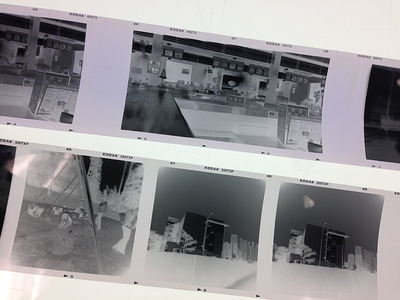Film Processing: Purple-Pink Negatives - 400 Tri X
 Friday, February 15, 2013 at 2:41PM
Friday, February 15, 2013 at 2:41PM As I recently have been processing my film, I've noticed that the negatives have a distinct purple cast. I wasn't sure what the problem was, and searching for the problem and solution on the internet, I've seen lots of different theories about it.
What it reminded me of, is the cast that TMAX has. TMAX negatives have a similar cast, and the solution to the problem is vigorous agitation during the fixing process, and an extended fixing time (4-5 minutes).
In the image above, the "new" 400 Tri X is the top negative, and the older (now discontinued) Tri X 320 is below. You can easily see the pinkish-purplish cast.
The image is clickable to a higher res version, if you would like to take a closer look.
I have modified my fixing process to continuously invert my processing tank for 5 minutes, and that seems to have reduced the problem. The negatives still have a slight purple tint, but it isn't as pronounced or uneven as before.
I think that Kodak has tweaked Tri X to include some of the same physical characteristics as TMAX. The purple pink tint might be the anti-halation coating they use on the film backing.
By the way, the wide negative above is the 6x12 negative from my Lomography Belair. It looks good and I look forward to getting the scan done, which I will do by using my iPhone, but more on that later!
 kaiy |
kaiy |  Post a Comment |
Post a Comment |  Belair,
Belair,  Purple cast,
Purple cast,  Tri-X,
Tri-X,  TriX,
TriX,  film processing,
film processing,  negatives in
negatives in  Darkroom
Darkroom 

